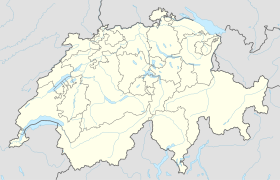Tartar GR
| GR is the abbreviation for the canton of Graubünden in Switzerland and is used to avoid confusion with other entries of the name Tartar . |
| Tartare | ||
|---|---|---|
| State : |
|
|
| Canton : |
|
|
| Region : | Viamala | |
| Political community : | Cazis | |
| Postal code : | 7422 | |
| former BFS no. : | 3667 | |
| Coordinates : | 751 425 / 176 160 | |
| Height : | 995 m above sea level M. | |
| Area : | 1.55 km² | |
| Residents: | 162 (December 31, 2009) | |
| Population density : | 105 inhabitants per km² | |
| Website: | www.tartar.ch | |
|
Tartar GR |
||
| map | ||
|
|
||
Tartar was a municipality in the former county Thusis , Bezirk Hinterrhein , the Swiss canton of Grisons .
On January 1, 2010, the municipalities of Cazis , Portein , Präz , Sarn and Tartar merged to form the new municipality of Cazis.
geography
Tartar is on the outer Heinzenberg . It has enough children to run its own school. Thanks to a generous sponsorship of the Basel-based community of Muttenz , Tartar was able to afford its own community hall, which, like all community-owned buildings, is supplied with electricity by a small stream power station. While few people work within the community, tourism is a sideline for some. There are many holiday homes on the parish grounds; a total of 1100 overnight stays by tourists are booked annually. A third of the municipal area is covered by forest.
history
Tartar is first mentioned in documents around 1290 as Tartere, which means something like steppe, undeveloped land or wasteland . At that time, Tartar was subordinate to the Lords of Schauenstein, who lived in Ehrenfels Castle . While German is spoken almost exclusively in Tartar today , it used to be a Rhaeto-Romanic community, as indicated by many field names. Between 1530 and 1540 the village was reformed.
Originally, Tartar was a much larger community than it is today and was shaped by wine and chestnut growing . But when a major fire destroyed most of the houses, stables and barns in Tartar in 1806, many residents were forced to sell their farmland and pasture land to neighboring communities in order to survive financially.
coat of arms
Description: Divided by a red bar, above in silver (white) a growing blue, red armored lion , below in the cloud section divided by silver and blue. The lion stands for the affiliation of the community to the former court Thusis, the cloud section is an element of the coat of arms of the Lords of Schauenstein, who were the landlords of the place.
population
| Population development | ||||||||||
|---|---|---|---|---|---|---|---|---|---|---|
| year | 1808 | 1850 | 1900 | 1920 | 1950 | 1980 | 1990 | 2000 | 2005 | 2009 |
| Residents | 100 | 170 | 146 | 206 | 188 | 105 | 161 | 158 | 173 | 162 |
languages
Until the 19th century the population spoke Sutselvisch , a Graubünden Romanesque dialect. The language change to German took place very early on. In 1860 and 1870 the community was still mixed languages, but by 1888 only 44 (= 24%) of the 185 residents at the time stated Romansh as their mother tongue. This value fell to 20% by 1910 and to 11% in 1941. Today the community is almost monolingual. German is the only official language. The following table shows the development over the last few decades:
| languages | 1980 census | 1990 census | 2000 census | |||
|---|---|---|---|---|---|---|
| number | proportion of | number | proportion of | number | proportion of | |
| German | 98 | 93.33% | 144 | 89.44% | 154 | 97.47% |
| Romansh | 6th | 5.71% | 4th | 2.48% | 1 | 0.63% |
| Italian | 0 | 0.00% | 4th | 2.48% | 3 | 1.90% |
| Residents | 105 | 100% | 161 | 100% | 158 | 100% |
Origin and nationality
Of the 173 residents at the end of 2005, 169 (= 97.69%) were Swiss citizens.
Attractions
The reformed village church is a listed building .
literature
- Jürg Simonett: Tartar. In: Historical Lexicon of Switzerland . 2016 .
- Erwin Poeschel : The art monuments of the canton of Graubünden. Volume III: The valleys of Räzünser Boden, Domleschg, Heinzenberg, Oberhalbstein, Upper and Lower Engadine (= Swiss art monuments. Volume 11). Edited by the Society for Swiss Art History GSK. Bern 1940. DNB 760079625 .
- Mathias Kundert: The language change in Domleschg and on Heinzenberg (19th / 20th century). Commission publisher Desertina, Chur 2007, ISBN 978-3-85637-340-5 .



